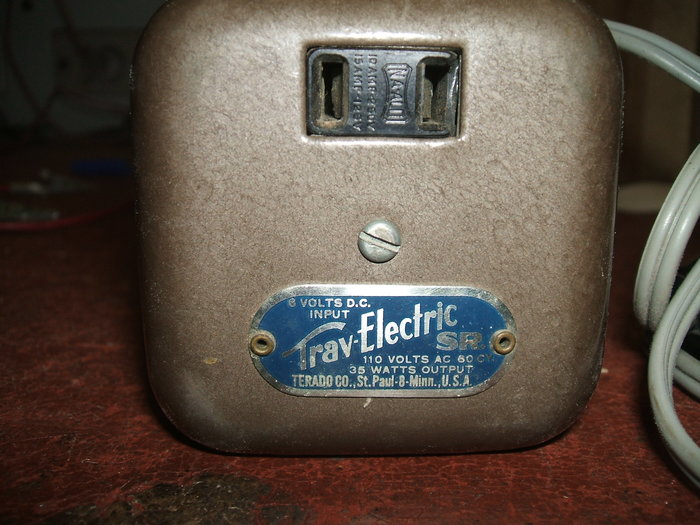
Terado was famed for their popular and compact inverters during the 1950's and 1960's.

Terado was famed for their popular and compact inverters during
the 1950's and 1960's.
If you read electronics magazines from the U.S. from the 1950's, you would have seen the prolific amount of Terado advertisements. I've bought a few Terado models on the U.S. ebay as they tend to go very cheap and are usually in very good condition. The Trav-Electric SR described here has an input of 6V DC and an output of 110V 60c/s at 35W. Being 6V, it's ideal to use in my Model T Ford. It can power my small U.S. made mantel radios, or appliances like switchmode power supplies rated for 100-240V.
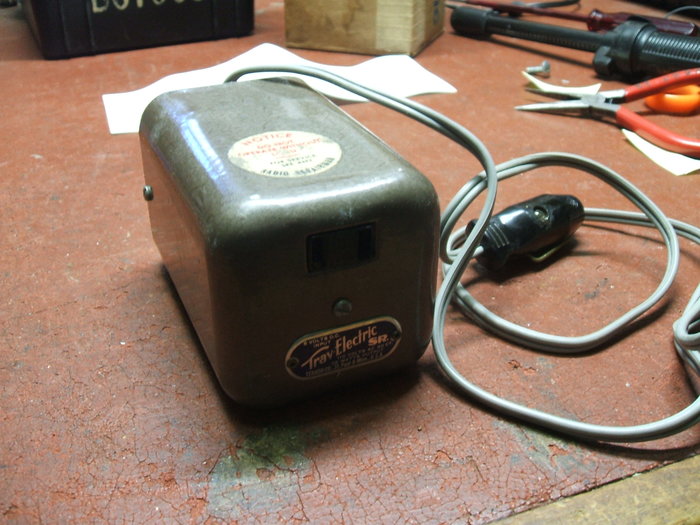
Some idea of the compact size can be seen by comparison to the cigarette
lighter plug.
The circuit is completely conventional except for one thing. As is usual, the DC supply is fed into the transformer primary centre tap and the outer connections are alternately switched to earth by the vibrator contacts, creating the changing magnetic field required by the transformer. Buffer capacitance is provided to tune the transformer to the vibrator; in this case to 60c/s. Input filtering for RFI is provided by a choke and .5uF condenser on the 6V supply. Output filtering is similarly provided by the choke in series with the 110V output socket, along with the .1uF buffer condenser.
The Circuit.
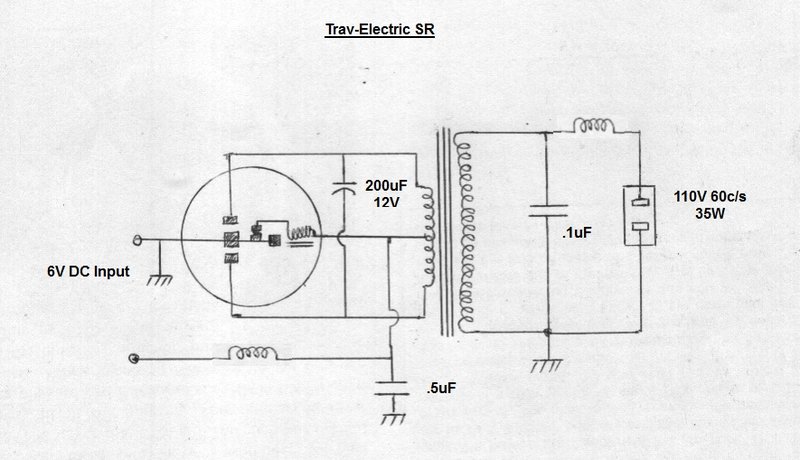
The circuit is electrically very simple.
However, the point of interest is the buffer
capacitance. As well as the usual .1uF on the secondary, there is 200uF
across the primary. This in itself is perfectly legitimate, and in fact
having most of the buffer capacitance on the primary is desirable. In practice
however, convention is to have most of the capacitance on the secondary
because it means a smaller capacitor can be used. This was an important
consideration when high value paper capacitors were very large and bulky
components. The value of the capacitor, if connected to the secondary,
is reduced by the square of the turns ratio.
With the Trav-Electric inverter, the buffer
capacitance is an electrolytic type. It is clearly marked as such, and
the polarity markings further confirm this. This is completely against
convention; having a polarised electrolytic capacitor connected directly
across an AC supply.
No doubt, the reason for doing so is to
keep the inverter so compact. Without the 200uF electrolytic, it would
be necessary to have a secondary buffer of around 3uF. This would certainly
not fit in the available space. But applying AC directly to a polarised
electrolytic capacitor, to say nothing of the ripple current, just seems
like an appalling thing to do. Yet, this well known manufacturer has done
just that.
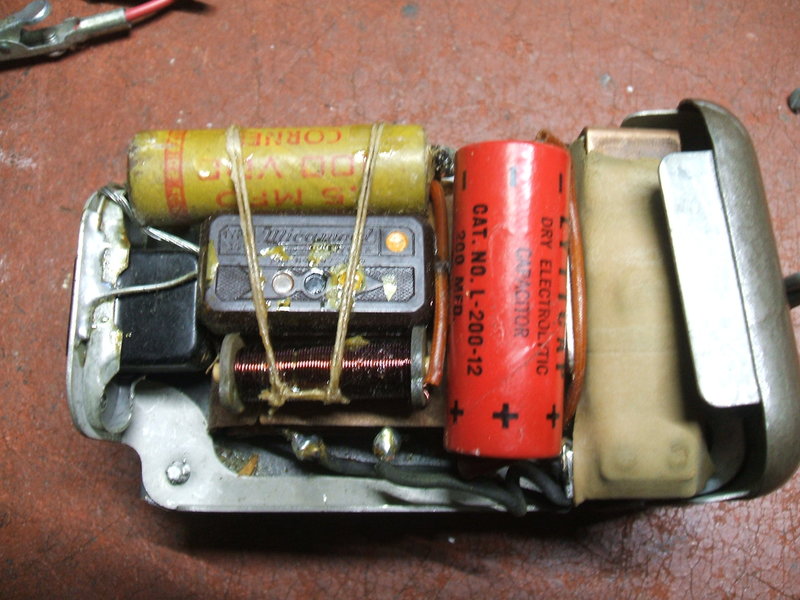
Inside the inverter. The 200uF 12V electrolytic buffer capacitor
is visible. The mica capacitor is the .1uF secondary buffer.
Despite this, the inverter obviously works. The 200uF does not get hot, and the vibrator contacts do not arc. Even a non polarised electrolytic would still not be the right component because of the ripple current. One can only assume that the capacitor they've used here is large enough that it can dissipate any heat formed during the reverse part of the cycle.
A short twin flex cable with cigarette lighter plug connects the inverter to the car's electrical system. Note that there is no fuse provided which is poor design practice. Presumably it was omitted because of space constraints, and the assumption would be the cigarette lighter socket would be fused anyway. What the cigarette lighter would be fused at is anyone's guess, assuming it's fused at all. So, with the right kind of overload it would be possible to burn out the transformer and/or vibrator contacts.
Vibrator.
As in the other Terado models using an
open vibrator, it is obvious that an Oak type is used. Extra weight is
added to the reed so that it oscillates at 60 cycles instead of 100.
The construction is virtually identical
to the Oak vibrators made
in Australia by MSP.
These are series driven types which means
the starting and vibrating of the reed is not dependent on the loading
or condition of the transformer switching contacts.
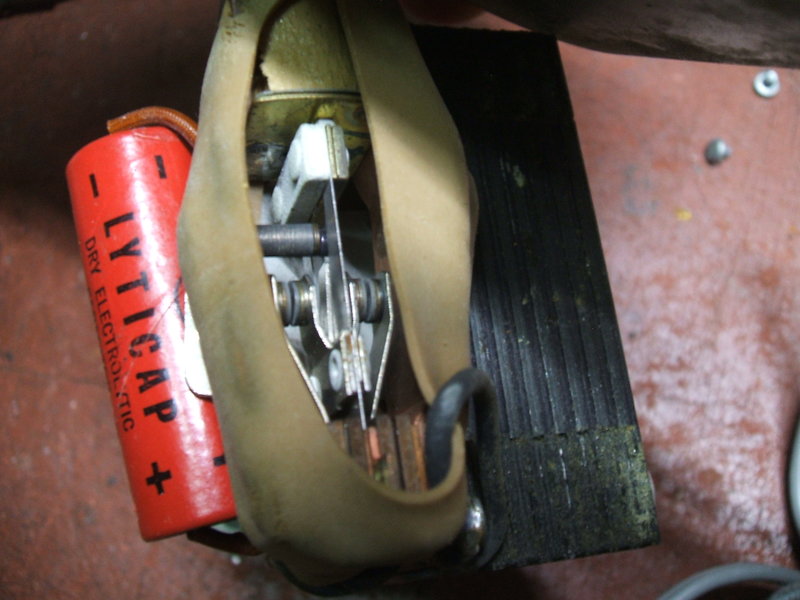
Close up of vibrator shows it to be of the Oak design.
Unlike most other applications, the vibrator is not enclosed in a can. It's an open assembly with a rubber shroud over it to prevent it shorting to other components and to provide some mechanical insulation. The transformer and 200uF are connected directly to the vibrator stack without any socket. Being an Oak type, reliability is a non issue, so it's doubtful the vibrator would have to be ever replaced.
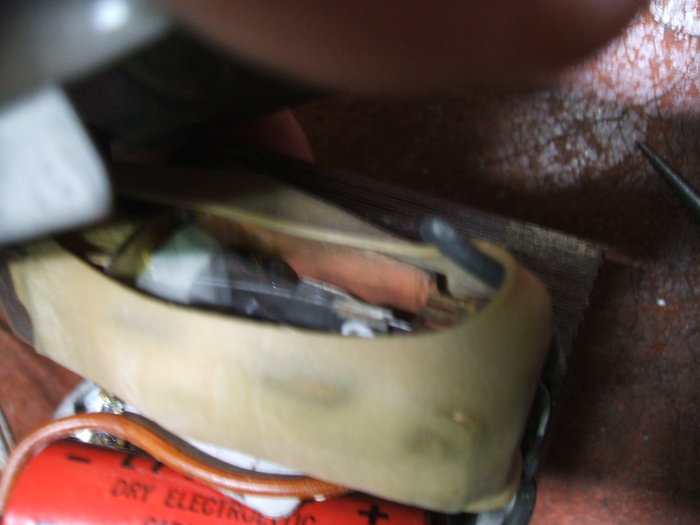
Vibrator can be seen in action here.
No components were replaced as the only paper capacitor is the 6V bypass and does not matter if it is leaky. The secondary buffer is mica and very unlikely to fail. One can only guess at the 200uF electrolytic, but to test it would mean desoldering it which I was reluctant to do. The output waveform shows no spikes, and the contacts don't spark, so I figure its best to leave it in situ. What would one replace it with anyway? A non polarised type of the largest size that fitted into the space would probably be the best option, or two back to back 470uF 25V electrolytics of similarly large size.
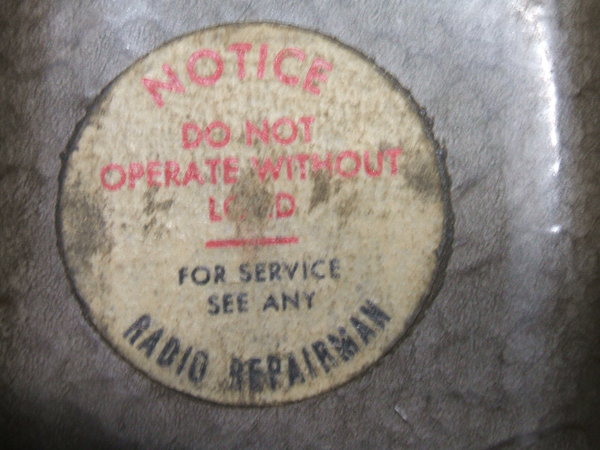
Like many vibrator inverters, warning is given not to run them unloaded.
There is the usual warning about not running the inverter without a load. This is because the buffer capacitor is optimised for loaded conditions. Unloaded, the same buffer capacitance value is too high, and can in some instances cause contact sparking. In this inverter there is no visible sparking when run on no load, but current draw is higher than normal.